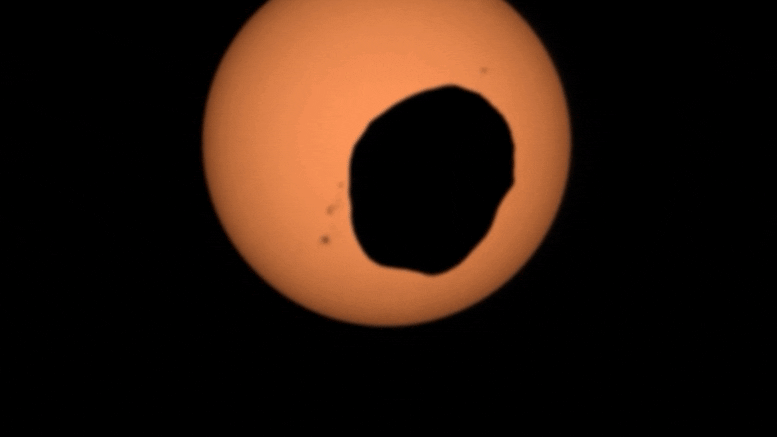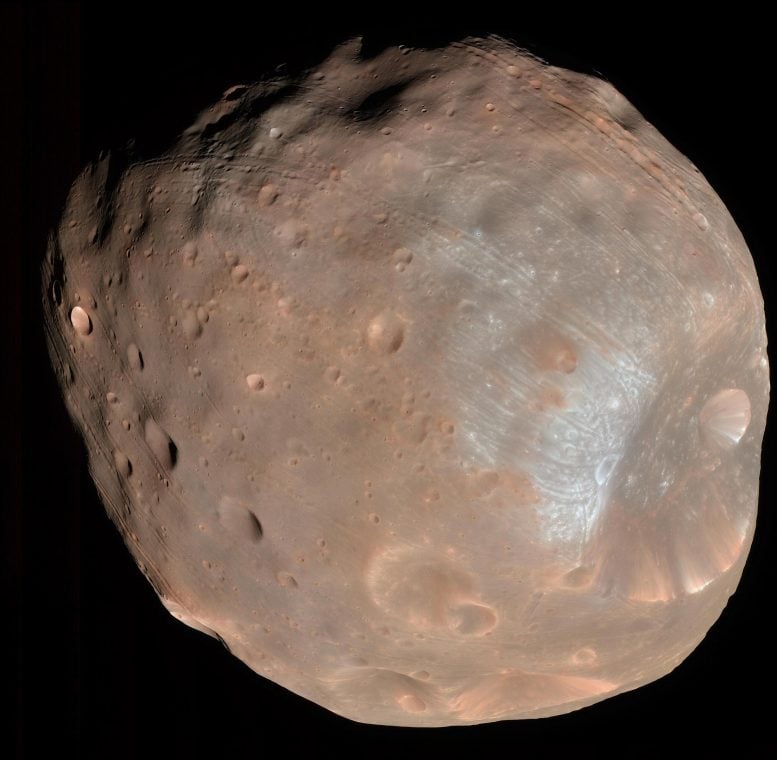
NASA’s Perseverance Mars rover used its Mastcam-Z camera to shoot video of Phobos, one of Mars’ two moons, eclipsing the Sun. Credit: NASA/JPL-Caltech/ASU/MSSS/SSI
NASA’s Perseverance Mars rover used its Mastcam-Z camera system to shoot video of one of Mars’ two moons, Phobos, eclipsing the Sun. It’s the most zoomed-in, highest frame-rate observation of a Phobos solar eclipse ever taken from the Martian surface.
“I knew it was going to be good, but I didn’t expect it to be this amazing,” said Rachel Howson of Malin Space Science Systems in San Diego, one of the Mastcam-Z team members who operates the camera.
Several Mars rovers have observed Phobos crossing in front of the Sun over the past 18 years. Spirit and Opportunity made the first time-lapse photos of Phobos back in 2004; NASA’s Curiosity rover was the first to record video of the event in 2019.
NASA’s Perseverance Mars rover used its Mastcam-Z camera to shoot video of Phobos, one of Mars’ two moons, eclipsing the Sun. It’s the most zoomed-in, highest-frame-rate observation of a Phobos solar eclipse ever taken from the Martian surface. Credit: NASA/JPL-Caltech/ASU/MSSS/SSI
Each time these eclipses are observed, they allow scientists to measure subtle shifts in Phobos’ orbit over time. The moon’s tidal forces pull on the deep interior of the Red Planet, as well as its crust and mantle; studying how much Phobos shifts over time reveals something about how resistant the crust and mantle are, and thus what kinds of materials they’re made of.
Phobos is about 157 times smaller than Earth’s Moon. Mars’ other moon, Deimos, is even smaller.
Both of Mars’s moons, Phobos and Deimos, were discovered in 1877 by American astronomer Asaph Hall. He named them for the mythological sons of Ares, the Greek counterpart of the Roman god, Mars. Phobos, whose name means fear is the brother of Deimos.
Phobos, gouged and nearly shattered by a giant impact crater and beaten by thousands of meteorite impacts, is on a collision course with Mars. It is nearing Mars at a rate of six feet (1.8 meters) every hundred years. At this rate, it will either crash into Mars in 50 million years or break up into a ring.
Phobos is the larger of Mars’ two moons and is 17 x 14 x 11 miles (27 by 22 by 18 kilometers) in diameter. It orbits Mars three times a day and is so close to the planet’s surface that it cannot be seen from some locations.
Its most prominent feature is the 6-mile (9.7 kilometer) crater Stickney, its impact causing streak patterns across the moon’s surface. Stickney was seen by Mars Global Surveyor to be filled with fine dust, with evidence of boulders sliding down its sloped surface.
For more about this video, see Incredible Video of Solar Eclipse on Mars – Captured by NASA’s Perseverance Rover.









Be the first to comment on "What Does a Solar Eclipse Look Like on Mars? NASA’s Perseverance Mars Rover Captures “Amazing” Video"